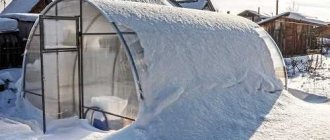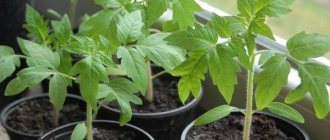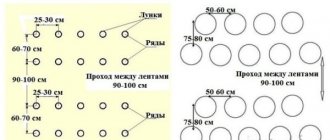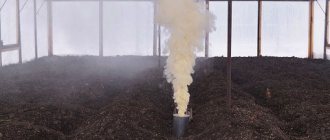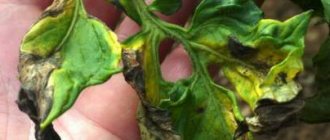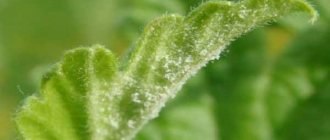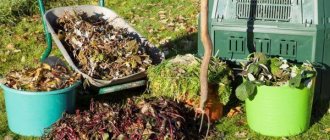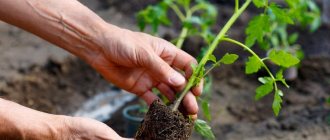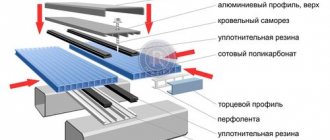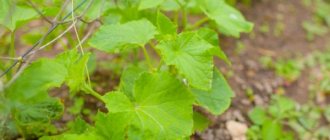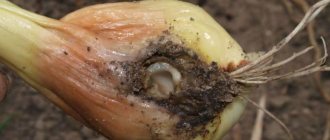The cultivation of land with copper sulfate has been carried out in gardening and vegetable growing for a long time and successfully. This is one of the most common fungicides that counteracts dangerous plant diseases and has a beneficial effect on crops. Enriches the soil and increases acidity. Copper sulfate is widely used to disinfect greenhouses, and autumn treatment of soil, shrubs, and trees significantly reduces the risk of contracting various infections. The advantages include efficiency, environmental friendliness and relative safety.
Characteristics of copper sulfate
Copper sulfate is an inorganic substance that is produced industrially and is called copper sulfate. In appearance it resembles crystals of various shades of blue.
In nature, copper sulfate is found in other minerals. It dissolves well in cold water, but much faster in hot water, resulting in a blue-colored drug.
The substance is moderately toxic for warm-blooded animals, but since it is highly stable in the ground, it is dangerous for soil fauna and microflora.
To prevent it from reacting with iron, it should not be dissolved and stored in a metal container. Copper sulfate is incompatible with insecticides that contain phosphorus and substances that decompose in an alkaline environment.
GOST 19347-99 has been developed for copper sulfate used in agriculture.
Folk remedies for treating greenhouses in spring
For those who do not like to use chemicals on their site, treating the greenhouse with folk remedies is suitable. They require a little more time and effort, but will reduce financial costs and are more environmentally friendly. Infusions of garlic, mustard, onion peels and tobacco perfectly disinfect soil and walls. They may not be as effective as chemicals, but they are definitely environmentally friendly. Fumigation and the use of potassium permanganate are also relevant.
Treating a greenhouse with a sulfur bomb in spring
The so-called sulfur block is a set of sulfur tablets. When smoldering, it releases sulfur dioxide, which kills fungi, viruses, bacteria, and insects. To treat a room, take the required number of tablets designed for a certain volume of the room. They are set on fire with a wick and left to smolder in a closed building. This produces a large amount of smoke that fills the structure. It penetrates into all hard-to-reach places, even joints and crevices.
Treating a greenhouse with a sulfur bomb - what are the benefits and harms: the advantages of a sulfur bomb include:
- effective against mold, mildew, insects and bacteria;
- has high penetrating ability;
- easy to use and economical.
But there are also disadvantages:
- Sulfur dioxide destroys the metal parts of the frame (they must be covered).
- Polycarbonate becomes cloudy after sulfur and becomes covered with cracks.
- The reaction of smoke with water produces an acid that kills both harmful and beneficial microorganisms. As a result, soil fertility decreases.
Application of inorganic substance
To resist pests and ensure full development of plants, the fungicide is needed in small quantities. Its antiseptic properties:
- protects crops from diseases;
- makes plants immune to fungal diseases;
- improves the quality of soil with a lack of humus and copper deficiency;
- increases the resistance of plantings to frost.
It is advisable to use copper sulfate as a prophylactic agent.
The frequency of application of the substance depends primarily on the characteristics of the soil. Excessive consumption of copper sulfate can lead to the following consequences:
- accumulated copper in the soil disrupts the interaction of macro- and microelements;
- nitrous emissions increase;
- nitrogen metabolism and the intensity of soil respiration decreases;
- difficulties arise in the access of iron and phosphorus to plants;
- the activity of nutrients is inhibited;
- the influence of harmful organic matter increases.
Tilling the land in the spring is the most effective time for copper sulfate. As soon as the air temperature rises above +5 ºС, trees, shrubs and soil should be prepared for processing. It is not recommended to use the substance in summer.
In the autumn, copper sulfate should be used to prevent diseases. The area is processed when the entire crop has been harvested, the foliage has fallen and the area is prepared for winter. Then the substance penetrates fungal diseases without obstacles, destroying them.
Copper sulfate treatment
There are many varieties of copper sulfate solutions, it depends on the goals that need to be achieved. There are 3 types:
- Feeding. It is used to fertilize and feed the soil. It can be used to prevent certain diseases and to restore the balance of copper in the plant. To do this, water in a volume of 10 liters is mixed with 20-30 g of the substance.
- Medicinal. Used to treat fungal diseases and fight insects. The plant is treated with it to heal damaged shoots. Solution concentration 0.5% - 1%.
- Burning out. Used in exceptional cases to disinfect soil and burn out mold. Typically, land treated with a 3 - 5% solution is not used for a year.
It is better to prepare the drug immediately before use, and store the prepared drug for no more than 10 hours.
The soil
Copper sulfate as a microfertilizer for soil is used in areas where there is not enough copper in the soil. This should be done in the fall or early spring no more than once every 5 years. The use of the substance in summer can lead to the death of minerals in the ground. Frequent use of vitriol can not only oversaturate the earth with copper, but also poison it.
Soil disinfection is done with a preparation based on 3 g of copper sulfate per 10 liters of water. Fertilizer of the land is carried out with a mixture in the proportion of 1 g of substance per 1 m². After harvesting, in order to prevent diseases next year, the soil is treated with a mixture of 10 liters of liquid and one tablespoon of the substance. The concentration of the drug before boiling should be 1 g of copper sulfate per 1 liter of liquid.
Garden
To prevent diseases, the garden should be treated in late autumn and early spring. Using the drug, you can treat trees not only against pests, but also against black cancer, brown leaf spot, scab, cytosporosis, and fruit rot.
| Name of culture | Consumption of the drug per 10 liters of water |
| quince, pear, apple tree | 100 g |
| plum, peach, cherry, sweet cherry, apricot | 50 – 100 g |
| currants, gooseberries | 50 – 100 g |
Before treatment, the plants are prepared for spraying. They carry out pruning, clear loose bark from tree trunks, cover cracks and cuts with garden varnish, and remove last year's foliage around the trees.
Autumn treatment is the most effective. There is from 2 liters to 5 liters of copper sulfate solution per tree, and up to 1.5 liters per bush. In order not to burn the plants, you must strictly adhere to the consumption rates of copper sulfate.
Vegetables
Often crops are susceptible to fungal diseases and therefore need to be treated with copper sulfate. If vegetables receive the substance in sufficient quantities, their resistance to diseases will be higher.
Planting tomatoes, zucchini, and squash begins with pre-sowing seed preparation. To disinfect them, they are soaked for 15 minutes in a disinfectant solution, which contains 1 g of copper sulfate, 2 g of boric acid and 10 g of potassium permanganate per 10 liters of liquid. Before planting, the seeds should be washed with clean water.
In order for cucumbers, carrots, beets, celery, and onions to sprout quickly, their seeds are soaked in a solution mixture consisting of 3 g of copper sulfate and 10 liters of water.
Before planting, it is advisable to spray potato tubers with a 2% solution of the substance to prevent late blight.
You can protect garlic shoots from diseases and help the cloves survive the winter if you soak the garlic in a 1% copper sulfate solution for 12 hours before planting.
Greenhouses
Before autumn treatment, the greenhouse must be thoroughly washed, then a solution of bleach is added to the soil. From 0.4 kg to 1 kg of bleach is diluted in a ten-liter bucket of water. To treat a greenhouse with copper sulfate, 75 g of the substance is diluted in a 10-liter bucket of water, its dosage is increased to 200 g in case of damage to plants that were in the greenhouse by insects.
The soil in the greenhouse is treated with copper sulfate along with other disinfectants. First, the soil is dug up along with dry lime. And if the soil has been infested with pests, it is treated with a 40% formaldehyde solution. 100 ml of formalin is diluted in 10 liters of liquid, 20 liters of solution are consumed per 1 m² of area. Now you can start treating the soil with copper sulfate at the rate of one tablespoon per ten-liter bucket of water.
Greenhouse treatment in spring
The first reason for spring treatment of greenhouses is the destruction of seeds and roots of weeds, the elimination of larvae and parasites, and the removal of mold and fungi. You need to start preparing for the next season immediately after the snow melts. Before treating your greenhouse with disinfectants in the spring, you need to get rid of old plant debris and repair it. Then you can begin to destroy pathogenic microflora and parasites that survived over the winter. There are sequential steps and methods for processing a greenhouse in the spring:
- Before the snow melts, it is better to freeze the structure to destroy microbes susceptible to cold. To do this, you need to open the doors for several days, spread snow over the beds - it will saturate the earth with beneficial soft water.
- Then, 1-1.5 months before planting, the structure is washed from the inside and outside with soapy water and wiped with a clean cloth.
- At the next stage, disinfection is carried out - an important manipulation. For this, fumigation techniques with sulfur bombs, irrigation with biological products or folk remedies are useful.
- The last stage is increasing soil fertility. To do this, its outer layer 12-15 cm thick is replaced with a new one. Afterwards the ground must be treated using one of the following methods:
- Scald with boiling water at the rate of 3 liters per 1 m2 of area.
- Steam - pour boiling water and cover with film. The steam penetrates deeply and destroys parasites.
- Fill with 3% nitrafen solution. It will destroy wintering mites, pupae, parasite eggs, and fungal spores.
- Treat with a 2% carbation solution; it is added to loose soil. After the gravy has been applied, the soil must be dug up again.
Safety during processing
According to GOST 12.1.007, copper sulfate is a drug of the second class of hazard and third class of toxicity. Penetrating into human organs during operation, it can cause gastrointestinal disorders. Therefore, safety precautions should be observed when working with the drug.
The dosage of drugs containing copper sulfate must strictly comply with the requirements of the instructions for their use.
Before you start working with copper sulfate, you should take care of work clothes, gloves and shoes that are easy to clean. Goggles and a respirator will be useful.
- Do not prepare the solution in a container that is used as an object for storing food or drinking water.
- To prevent the evaporation of a dangerous chemical, it should be used at atmospheric temperatures below +30 ºС.
- When working with a solution of the substance, the presence of unprotected people or animals should be avoided.
- Do not cultivate the soil or plants in windy weather or when crops are flowering.
- Do not pour the solution into bodies of water, as it is highly toxic to the aquatic environment.
- After finishing working with the substance, you must wash your hands.
Compliance with the rules will prevent the negative impact of copper sulfate on humans.
